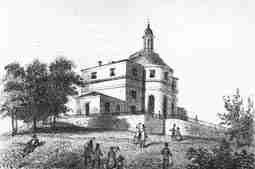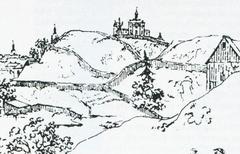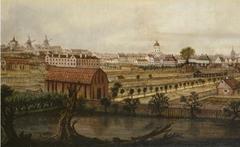
Stockholm Observatory Visiting Hours, Tickets, and Travel Guide
Date: 14/06/2025
Introduction
Perched atop Observatorielunden hill in Stockholm’s Vasastan district, the Stockholm Observatory (Stockholms observatorium) is a beacon of Sweden’s scientific and cultural heritage. Established in 1753 by the Royal Swedish Academy of Sciences and designed by Carl Hårleman, this landmark seamlessly blends Enlightenment-era architecture with a legacy of astronomical and meteorological innovation (Astronomical Heritage; Stockholm University). Today, visitors can enjoy panoramic city views, explore historic scientific instruments, and experience the intersection of science, history, and culture.
This comprehensive guide details the observatory’s history, practical visitor information—including current visiting hours and ticketing—accessibility tips, and nearby attractions, ensuring you make the most of your visit.
Table of Contents
Historical Overview
Origins and Construction
The Stockholm Observatory was established in the mid-18th century to advance Sweden’s astronomical research. Construction began in 1748 and concluded in 1753 atop Observatorielunden, providing both elevation and, at the time, optimal darkness for celestial studies. Carl Hårleman’s neoclassical design prioritized both scientific functionality and elegance, featuring a central round observation room to accommodate large instruments (Astronomical Heritage).
Scientific Achievements and Instrumentation
From its earliest days, the observatory was equipped with leading-edge instruments such as the John Dollond achromatic refractor, a quadrant by John Bird, and a Gregorian reflector by William Cary. These tools enabled Swedish astronomers to pioneer research in astrometry and celestial mechanics. A marble-inlaid meridian line served as Sweden’s national zero meridian, while the Meridian Room was central to timekeeping in Stockholm (Astronomical Heritage).
Meteorological Legacy
The Stockholm Observatory is renowned for maintaining the world’s longest continuous daily weather observation record, dating back to 1756. Under the direction of Pehr Wilhelm Wargentin, systematic measurements of temperature, air pressure, rainfall, and snow depth began and have continued uninterrupted. This dataset, now managed by the Swedish Meteorological and Hydrological Institute (SMHI), is invaluable for long-term climate research (SMHI).
19th-20th Century Development
Throughout the 19th century, the observatory expanded its facilities, including a magnetic house for geomagnetic studies and a new tower with a dome. Directors like Hugo Gyldén and Bertil Lindblad advanced astrophotography and our understanding of galactic rotation. As Stockholm grew, increasing light pollution necessitated the relocation of primary astronomical research to a new facility at Saltsjöbaden in 1931, designed by Axel Anderberg (Astrofriend).
Museum Era and Public Engagement
After the move to Saltsjöbaden, the original observatory operated as a museum from 1991, managed successively by the Observatory Hill Foundation and the Royal Swedish Academy of Sciences. Exhibits included Wargentin’s study, the Old and New Meridian Rooms, historical instruments, and the Weather Room. Although the museum closed to the public in 2014, recent plans by SISAB aim to revive the site as an educational platform for students and teachers (Astronomical Heritage).
Architectural and Cultural Significance
The observatory’s neoclassical architecture, hilltop setting, and preserved interiors make it a unique cultural landmark. Its proximity to the Stockholm Public Library and Strindberg Museum further enhances its appeal (City Guide Stockholm; Not About the Miles).
Visitor Information
Visiting Hours
-
Current Status: The observatory does not operate as a daily museum, but special events and guided tours are occasionally organized. Always check the official museum or city websites or contact SISAB and the House of Science for the latest updates on visiting hours.
-
Typical Hours (when open): Tuesday–Sunday, 11:00 AM–5:00 PM (extended during summer; subject to change and special events).
Tickets and Admission
- General Admission: SEK 60 (approx. $6–7 USD).
- Discounts: SEK 40 for students, seniors, and children under 18; free entry for children under 7 and Stockholm residents on select days.
- Guided Tours: SEK 100 per person; advance booking recommended.
- Special Events: Check event-specific pricing on the museum’s official page or Stockholm educational platforms.
Accessibility
- Facilities: The park and main paths are generally accessible for wheelchairs and strollers. Due to the building’s historic nature, access to the dome and upper floors is limited.
- Restrooms and Café: Accessible facilities are available in the museum and at Café Himlavalvet.
- Assistance: Contact ahead for support or accommodations for visitors with disabilities.
Getting There
- Metro: Odenplan (Green Line), 5-minute walk.
- Bus: Several lines stop nearby along Odengatan and Sveavägen.
- Walking/Cycling: Central location allows easy access by foot or rental bike.
- Parking: Limited; public transport is advised (Visit Stockholm).
Nearby Attractions
- Stockholm Public Library: Architectural gem a short stroll away.
- Strindberg Museum: Literary history within walking distance.
- Observatorielunden Park: Expansive lawns, ponds, streams, and art sculptures.
- Café Himlavalvet: Relax with specialty waffles and refreshments overlooking the park (Visit Stockholm).
Visitor Tips
- Best Time to Visit: June offers long daylight hours and pleasant weather; winter brings a magical atmosphere, especially if the park’s pond freezes for ice skating.
- Photography: Sunrise and sunset provide optimal lighting for panoramic city and park views.
- Events: Watch for public lectures, night sky viewings, and special exhibitions during astronomical phenomena.
- Combine Visits: Explore Vasastan’s cafés and shops, Tegnérlunden park, and other nearby cultural sites.
- Language: Guided tours are available in Swedish and English; most staff are proficient in English.
- Etiquette: Maintain a quiet atmosphere in both the park and museum areas.
FAQ
What are the Stockholm Observatory visiting hours?
Usually Tuesday to Sunday, 11:00 AM–5:00 PM, with longer hours in summer. Check the official website for updates.
How much are tickets for Stockholm Observatory?
General admission is SEK 60, with discounts for students, seniors, and children. Guided tours cost extra and require advance booking.
Are guided tours available in English?
Yes, tours are offered in both Swedish and English.
Is the observatory accessible for visitors with mobility issues?
The park is mostly accessible, but the dome and some upper floors have limited access due to historic architecture.
Are there COVID-19 restrictions?
Policies may change; check the museum’s website before visiting.
Conclusion
The Stockholm Observatory is a testament to Sweden’s enduring commitment to science, culture, and public education. Its rich history, remarkable collections, and stunning city views make it an essential stop for travelers seeking a meaningful Stockholm experience. While regular museum hours may be limited, planning your visit around special events or guided tours ensures you’ll appreciate everything this landmark has to offer. Pair your trip with nearby attractions and enjoy the vibrant atmosphere of Vasastan.
For up-to-date information on opening hours, tickets, and upcoming programs, visit the official museum or tourism websites, download the Audiala app for guided tours, and follow Stockholm Observatory on social media.
References and Further Reading
- Astronomical Heritage
- Stockholm University
- Visit Stockholm - Stockholm Observatory
- Stockholm Museum: Observatorielunden
- Royal Swedish Academy of Sciences
- Swedish Meteorological and Hydrological Institute (SMHI)
- City Guide Stockholm
- Not About the Miles
- Stockholm University Astronomy Department






































































































































































